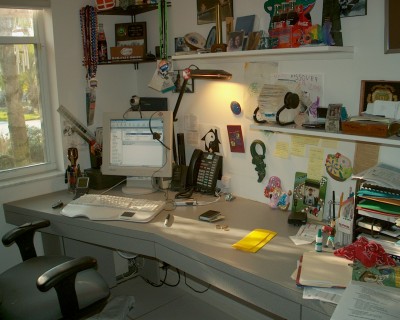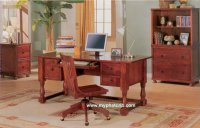Space for Home office
Tuesday, February 24th, 2009Basement conversion.
Dank and dungeon-like, our image of the typical unfinished basement is less than compelling. But if you can get past the creepy-movie associations, you may have found a large private space for your office. Split-level homes are prime candidates, as one or more walls may open out to light and an access door.
Moisture-proofing is crucial. Masonry walls should be sealed, insulated, then covered with gypsum wallboard or paneling. Build up the floor in the same way. If you can’t get rid of heating ducts and plumbing pipes, paint them jazzy colors or simply box them in with more wallboard.
Garage conversion.
With a little insulation, a weathertight door, a skylight, and a built-up floor, a garageâ€â€especially one that’s detached from the houseâ€â€could make a great home office. You could even add French doors and a sunny pocket deck.
Logistically, though, a garage remodel may prove daunting. Routing wires, pipes (if necessary), and heating ducts can be expensive. And where will the car go? In some communities, you’ll have to add a new garage or carport to make up for the off-street parking space you’ve lost.
A detached office.
For some, there’s nothing like grabbing a mug of coffee and a snack, then “commuting” to a secluded backyard office or pool-house studio. Perhaps a little-used guest house or revamped potting shed could become the place to hang your shingle. Or you could start from scratch, and get it right the first time.
But while a new building is the ultimate office solution, it could prove an especially expensive option. Besides the labor of building a separate foundation, walls, and roof, you’ll have to extend utilities to the site. You’ll probably wish (and may be required) to include a bathroom, which means routing both supply and waste pipes. You’ll need an independent heat source. If this is your first experience working at home, you might want to try it out on a smaller scale first.
EVALUATING YOUR SPACE
Before you rush off to empty the linen closet or dry out the basement, work out a wish list for the kind of office you’re looking for. Some of your requirements will be structural or equipment-based; others will relate more to your own personal work style. As plans take shape, test them against the questions listed below (each of these is explored more fully later on).
â– Are the area’s heating, cooling, and ventilation systems adequate to handle your office needs?
â– Will you have to add electrical circuits or extend phone lines?
â– Is the lightingâ€â€both natural and artificialâ€â€sufficient? Are there problems with glare? Do you need a view, or would one cause needless distraction?
â– What about privacy? Will you be disturbed by family members? Will household noise be transmitted over the phone? Will you be able to concentrate with loud traffic or neighbors outside?
â– Do you need a separate area for a postal scale, copier, project bins, or sample books?
â– Do you need extra bookshelves or space to display products?
â– If clients call on you, will the space project a suitable image? Is there room for a conference table and seating? When visitors approach your office, will your entire house (and family) be on display?
â– Do you need a separate outside entrance?

 If you are a full-time home-worker, you already know how much space it takes up, and this should be a priority when you are allocating rooms, if you are also part of a busy household, you will probably need to find a dedicated space that can be closed off for quiet and privacy. If you have the place entirely to yourself, you may prefer to create a work area in the main living space. Anyone who takes work home will appreciate a study if there Is room for it, but unless it is a priority, you will probably have to make do with a corner of the living room.
If you are a full-time home-worker, you already know how much space it takes up, and this should be a priority when you are allocating rooms, if you are also part of a busy household, you will probably need to find a dedicated space that can be closed off for quiet and privacy. If you have the place entirely to yourself, you may prefer to create a work area in the main living space. Anyone who takes work home will appreciate a study if there Is room for it, but unless it is a priority, you will probably have to make do with a corner of the living room. But now homeowners, designers, and manufacturers are taking a figurative step back, and a second wave of office design is the result. After all, if it’s your home, why dress it like a steno pool?
But now homeowners, designers, and manufacturers are taking a figurative step back, and a second wave of office design is the result. After all, if it’s your home, why dress it like a steno pool? Another boon in office awareness is that it’s now OK to admit you’re uncomfortable-and then do something about it. Take, for example, the development of form-fitting,
Another boon in office awareness is that it’s now OK to admit you’re uncomfortable-and then do something about it. Take, for example, the development of form-fitting, 